Medford school district to take health insurance premium hike rather than change plan options
School district employees and their families will get a pass this year as Medford School Board members voted Monday night to accept the renewal increase rate and keep the overall...

